A History of Hematology/Oncology Pharmacy

The story of oncology pharmacy takes us around the world and spans a few thousand years. One thing is for certain: As hematology/oncology pharmacists, we are part of a global cancer-fighting consortium.
For as long as there have been human beings, there have been people actively engaged in what these days, we might call "Optimizing Cancer Care."
- Jump to the 19th Century
- Jump to the 20th Century
- Jump to the 2000s and the start of HOPA
1500 BCE: Cancer in humans is described for the first time

Early Egyptian manuscripts are thought to be the first written descriptions of cancer in humans. However, the first pharmaceutical text appears to have been written much earlier, in 2100 BCE.
- Trivia Night Tip: There is evidence of cancer cells in dinosaur fossils dating back 80 million years.
Around 400 BCE
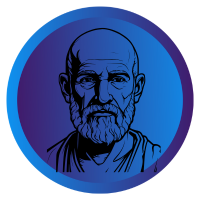
Where did "cancer" get its name? Let's ask Hippocrates! Around 400 BCE, the Greek physician and philosopher referred to cancer cells as "karkinos" - Greek for "crab" - because cancer cells grab onto whatever is within reach.
70-1600 AD
70 AD: The first oncology reference book is published
Pedanius Dioscorides, a Greek physician, pharmacologist, and botanist published De Materia Medica, which was the principal reference work on pharmacology across Europe and the Middle East for more than 1,500 years.
754 AD: Pharmacies begin to open
The first pharmacies opened in Baghdad in 754 AD. It wasn't until the 9th Century, however, that these pharmacies would be state regulated and pharmacists would be required to pass exams.
1045: The purpose of the pharmacy is defined, along with the role of the pharmacist
In 1045, Iranian scholar Al-Biruni wrote Kitab al-Saydalah (Book of Drugs), which was the first text to outline the role of the pharmacy, as well as the functions and duties of the pharmacist.

1221: The oldest still-operational pharmacy in the world opens
Santa Maria Novella Pharmacy opened in Florence, Italy, in 1221. Herbs used in the production of remedies were grown by Dominican monks living at the nearby Basilica. It is still operational to this day, making it the oldest, continually operated pharmacy in the world.

1441: The first school of pharmacy opens
The Royal College of Apothecaries of the City and Kingdom of Valencia, Spain was founded by King Alfonso V of Aragon to regulate the practice of pharmacy in the kingdom.
1617: Pharmacy is designated as its own entity within medicine
Having been granted a royal charter, The Society of Apothecaries is founded in London, England.

Mid 19th Century
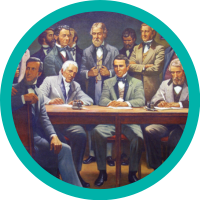
1852: The American Pharmaceutical Association is founded
On October 6, 1852, the American Pharmaceutical Association is founded by a group of 20 members. It is later renamed to the American Pharmacists Association.
1857: The term "oncology" is first used
The term "oncology" is published in R.G. Mayne's Expository Lexicon. The term would be more clearly established in Rudolf Virchow's Die krankheften Geschwülste in 1863.
1863: The connection is made between inflammation and cancer
Rudolf Virchow identifies white blood cells (leukocytes) in cancerous tissue, making the first connection between inflammation and cancer. Virchow also coins the term "leukemia" and is the first person to describe the excess number of white blood cells in the blood of patients with this disease.
Late 19th Century
During the ancient years, many cultures observed that, for some reason, tumors could occur on most any part of the body and spread. Parallel to that, people were discovering the medicinal qualities of herbs.
Then, in the late 19th Century and early 20th Century, as science and technology advanced, much more could be learned about the cause, composition, and pathology of cancer. In turn, more could be done to treat the disease using drug therapies.
1886: Family history is identified as a cancer risk factor
Brazilian ophthalmologist Hilário de Gouvêa reported that two of seven children born to a father who had been treated for childhood retinoblastoma also developed the disease.
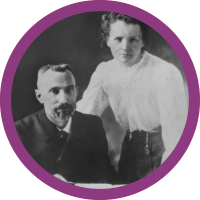
1898: Radium is proven effective at destroying diseased cells
Marie and Pierre Curie discover radium, and that it destroys diseased cells faster than healthy ones. This observation proved that radiation could be used to treat tumors and led to Marie coining the term, "radiology." The Polish-French physicist won two Nobel Prizes in 1903 and 1920 for Physics and Chemistry, respectively.

Early to mid 20th Century
The 20th Century brought into focus key treatments for cancer, some of which are still used today. Like so much of modern history, the field of hematology/oncology pharmacy was impacted by both world wars. It was also heavily influenced by advances in medicine, and an increase in government regulation and policy.
It is no coincidence then, that advocacy efforts began to take hold in the United States in the 1900s.
1902: Researchers learn why cancer cells divide uncontrollably
In 1902, German zoologist Theodor Boveri observed that cancerous tumors arose from single cells that had chromosome damage. His work suggests that chromosome alterations cause cells to divide uncontrollably.
1904: The first chemotherapy program is initiated
George Clowes initiates the first cancer chemotherapy program in the United States shortly after the term "chemotherapy" is coined by German chemist Paul Ehrlich.
1909: Immune surveillance research begins
After observing that the immune system normally suppresses tumor formation, Paul Ehrlich proposes a concept that becomes known as the "immune surveillance" hypothesis. The work to harness the power of the immune system still being done today is a direct result of this thinking.
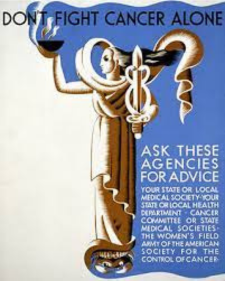
1913: America organizes to fight cancer
The American Society for the Control of Cancer (now known as the American Cancer Society) was founded by a group of doctors and advocates on May 22, 1913 at the Harvard Club in New York City.
The poster at your left - from the U.S. Public Health Service, in cooperation with the American Society for Control of Cancer - was created in 1938 but the sentiment behind it began 25 years earlier with the advent of patient advocacy. (Image credit: Library of Congress Public Domain Archive)
1915: A weapon becomes a cancer treatment
Mustard sulfur gas was first used in World War I as a chemical weapon, and went on to become the foundation of modern chemotherapy.
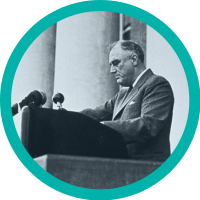
1937: National Cancer Act signed into law
U.S. Congress enacts the National Cancer Act, which is signed by President Franklin D. Roosevelt in 1937. This also marks the formation of the National Cancer Institute.
1953: A cancer tumor is cured for the first time
The drug methotrexate is used to successfully treat a patient with choriocarcinoma.
1958: The American Society of Hematology is founded
The American Society of Hematology is founded in 1958. In related drug breakthroughs, methotrexate continues to be used effectively to treat solid tumors, and vinblastine and vincristine are isolated from the common periwinkle plant, still used today as the basis for immunotherapy drugs.
Late 20th Century
1971: The second National Cancer Act is signed into law
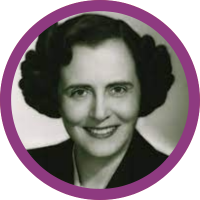
President Richard Nixon signs the National Cancer Act into law in 1971. Since then, the U.S. has invested more than $200 billion into cancer research.
Mary Lasker was a catalyst for the rapid growth of biomedical research in the United States after World War II and was instrumental in getting the second cancer act signed into law. She was called a "matchmaker between science and society" for her medical philanthropy and political activism.
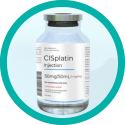
1978: Cisplatin enters the fight to treat cancer
Initially discovered in 1845, Cisplatin - the first platinum therapy - is approved by the FDA and licensed for medical use on cancer patients.
1982: The first taxane drug enters clinical trials
The first taxane drug, paclitaxel, entered clinical trials in 1982 and was soon found to be very useful for treating ovarian cancer, breast cancer, lung cancer, and more.
1986: The first biologic therapy for cancer is approved, as well as the first immunotherapy treatment
Interferon, the first biologic therapy for cancer, is approved by the FDA. Depending on the target cell, it exerts either an inhibitory or an inductive effect on cell differentiation.
Meanwhile, the FDA approves the first immunotherapy - Interferon-Alpha 2 - for the treatment of hairy cell leukemia.
1990s: The role of genetics in cancer is better understood
The discoveries of the TP53 gene and HER2 gene in the 1970s and 1980s helped propel this area of study. Crucial milestones came as the BRCA1 and BRCA2 tumor-suppressor genes were cloned in the mid-1990s.

1995: The story before the HOPA story
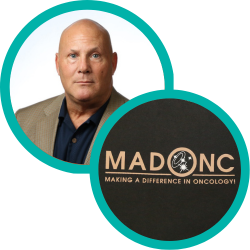
In 1995, a small, dedicated group of pharmacists formed Oncology New Concepts (ONC). Jody Simon was instrumental in bringing together these 10 pharmacists with a specialty interest in oncology practice who also possessed both clinical and administrative skills.
These practitioners went on to form MAD-ONC (Make A Difference in Oncology), the first collaborative group to address the need for educational and informational initiatives geared to oncology pharmacists.
1996
The Board of Pharmacy Specialties (BPS) approves the Board Certified Oncology Pharmacist (BCOP) specialty.
1998
Trastuzumab, the first targeted therapy for cancer, is approved by the FDA; Capecitabine is FDA-approved as the first oral anti-cancer therapy.
2000
The ACPE revises its standards and no longer accepts a B.S. in Pharma as the entry-level requirement for pharmacists in training. A PharmD is now required.
2002
A team at Memorial Sloan Kettering Cancer Center builds the first effective CAR-T cells against prostate cancer, part of the second generation of CAR-T technology.
2004: The birth of HOPA
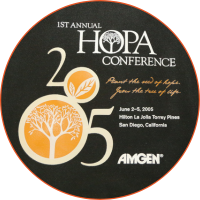
Nearly a decade after the formation of ONC, HOPA is founded on April 3, 2004 by a 33-person Board of Directors, including eight of ONC's founding members.
2005: The first Annual Conference
The first HOPA annual meeting is held in San Diego. The American Society of Health-System Pharmacists (ASHP), the American College of Clinical Pharmacy (ACCP), and HOPA combine to offer BCOP credits.
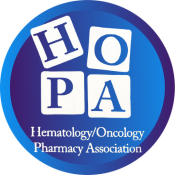
2007: HOPA continues to grow
HOPA membership reaches 1,000 members, and HOPA becomes an accredited provider of Accreditation Council for Pharmacy Education (ACPE) programs.
2013: Great scientific advancements
Ipilimumab is the first checkpoint inhibitor antibody to be approved by the FDA. HOPA, now two years into its Research Grant program, publishes Scope of Hematology/Oncology Pharmacy Practice.

2015: HOPA goes from strength to strength
HOPA is approved as a Board-Certified Oncology Pharmacist education provider, and holds its 10th anniversary conference in New Orleans. CINV Time To Talk also launches.
2016: A presidential mission
Vice President Biden launches Cancer Moonshot. Meanwhile, HOPA publishes Investigational Drug Service Best Practice Standards, and establishes the Fellows of HOPA designation with its first class of FHOPAs.
2017: CAR-T therapy advances
Tisagenlecleucel, the first commercially available CAR-T therapy, is approved by the FDA. HOPA also publishes Dose Rounding of Biologic and Cytotoxic Anticancer Agents Position Statement.
2018: HOPA publications
HOPA publishes Best Practices for Management of Oral Oncolytic Therapy: Pharmacy Practice Standard. ASHP-HOPA also publish guidelines on the roles and responsibilities on the pharmacy technician in ambulatory oncology pharmacy.

2021: Oral Chemotherapy Collaborative
HOPA creates the Oral Chemotherapy Collaborative, which is a program focused on optimizing the care of people taking oral anticancer agents.
2024 and onward
From their unique vantage points as oncology pharmacists, HOPA members will continue to redefine what it means to optimize cancer care.
References
Faguet, G.B. "A brief history of cancer: Age-old milestones underlying our current knowledge database." International Journal of Cancer. May 1, 2015; Volume 136, Issue 9, Pages 2022-2036
Chen, S., Chen, Q., Askool, Y. and Xu, L. "Textual Research on Dioscorides and De Materia Medica." Chinese Medicine. September 2023; 14, 208-2019
Hadzović S. "Pharmacy and the great contribution of Arab-Islamic science to its development." Medical Archives. 2017 Oct; 71(5), 364-372
Tschanz, David W. "The Islamic Roots of Modern Pharmacy." aramcoworld.com, May 2016
Carras, Jon. "Santa Maria Novella Pharmacy: The world's oldest pharmacy." cbsnews.com, May 19, 2019
National Institutes of Health. "Milestones in Cancer Research and Discovery." cancer.gov/research/progress/250-years-milestones, August 21, 2020
Worthen, Dennis B. "Founders of the American Pharmaceutical Association."
Journal of the American Pharmaceutical Association. Heroes of Pharmacy, Volume 42, Issue 6, P892-896, November 2002
Kovvali G. "Systems oncology: A new paradigm in cancer research." Journal of Carcinogenesis, 13:6; 2014
SEER Training Modules, Cancer Registration & Surveillance Modules. U.S. National Institutes of Health, National Cancer Institute. training.seer.cancer.gov/disease/cancer/terms.html
Janssen, D.F. "Oncology: etymology of the term." Medical Oncology 38, 22 (2021)
American Cancer Society. "Our History: The Early Years." cancer.org/about-us/who-we-are/our-history.html, October 5, 2024
Smith SL. "War! What is it good for? Mustard gas medicine." Canadian Medical Association Journal, February 27, 2017; 189
American Society of Hematology. "History of ASH." ash.org: https://www.hematology.org/about
ASCO Post. "The History of Medical Oncology in Europe, 1955-1985: Part 1: Early Pioneers, Clinical Trials, and Drug Development." ascopost.com December 10, 2021, Issue
Shaloam Dasari, Paul Bernard Tchounwou. "Cisplatin in cancer therapy: Molecular mechanisms of action." European Journal of Pharmacology, Volume 740, 2014, Pages 364-378
Ratih Asmana Ningrum. "Human Interferon Alpha-2b: A Therapeutic Protein for Cancer Treatment." Scientifica, vol. 2014
Rakesh Awasthi, Harald J. Maier, Jie Zhang & Stephen Lim. "Kymriah (tisagenlecleucel) - An overview of the clinical development journey of the first approved CAR-T therapy." Human Vaccines & Immunotherapeutics, Volume 19, 2023 - Issue 1


